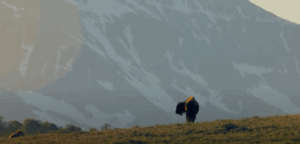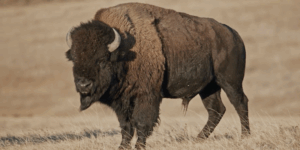The San Luis Obispo International Film Festival has given SLO Review the opportunity to preview some of the narrative and documentary films on the festival’s April 24-29, 2025 program schedule. Follow the links to purchase tickets to see these notable films for yourself.
A Stunning Resurrection Story
“After making us, He made the buffalo out of the very same clay. As soon as they took their first breath, they ran. So did we.” — From Bring Them Home
This year, Easter falls in April, so a film about a resurrection story seems appropriate. Bring Them Home is just that kind of story.
 But the resurrection, in this stunning film, is that of the Blackfeet people and their kinship with the American buffalo. But the enemy is powerful and intransigent. They are Blackfeet, too.
But the resurrection, in this stunning film, is that of the Blackfeet people and their kinship with the American buffalo. But the enemy is powerful and intransigent. They are Blackfeet, too.
This storyline is deceptively simple. It focuses on the people of two reservations, one in Montana and one in Alberta.
These are people whose lives once depended on buffalo, or Iinnii (the Blackfoot term), that provided meat and tools and sinew for sewing thread and horns for drinking cups. The Blackfeet, like other Plains tribes, drew sustenance from the buffalo the way that Irish or Portuguese or Japanese fishermen draw sustenance from the sea.
That, of course, ended in a century. The fate of the buffalo—narrated in this film objectively and effectively by Lily Gladstone from Killers of the Flower Moon—was catastrophic.
What ‘Bring Them Home’ argues, persuasively, is the psychological impact that this destruction has had on indigenous people.”
I grew up in Arroyo Grande, and one of the first films I saw, at the Fair Oaks Theater, was John Ford’s The Searchers. The scene that shows John Wayne’s Ethan wantonly shooting down buffalo shocked me at age five. It still does.
But that was the policy of the American government. “Kill every buffalo you can,” said “Indian fighting” Army officer Grenville Dodge in 1867. “Every buffalo dead is an Indian gone.”
Two years before, two Arroyo Grande settlers, soldiers, had participated in the Powder River Expedition, and their commanding officer had promised to kill every male Native American he found over the age of 12. The two soldiers were attacked in succession by Red Cloud, Sitting Bull, Crazy Horse, and Roman Nose. They eventually had to eat their own mounts to survive.
 So killing buffalo proved to be far more effective. It’s estimated that the 30 million buffalo that lived in North America in 1800—one mountain man watched a herd take three days to pass his camp—were reduced to about a thousand by 1900.
So killing buffalo proved to be far more effective. It’s estimated that the 30 million buffalo that lived in North America in 1800—one mountain man watched a herd take three days to pass his camp—were reduced to about a thousand by 1900.
What Bring Them Home argues, persuasively, is the psychological impact that this destruction has had on indigenous people. As the camera tracks communities punctuated by derelict homes—windowless, doors ajar, collapsed walls with insulation exposed—Gladstone talks about the people who once lived inside, stalked by depression, substance abuse, suicide.
None of these lost people had ever seen buffalo.
So young Blackfeet, in both Montana and Alberta, began in the 1980s what would become a 40-year campaign to bring buffalo back to their reservations. The reconnection with the animals that had sustained their ancestors was intended to reconnect their people to the animals that had sustained them spiritually and psychologically as well.
The Blackfeet buffalo people found opposition: Blackfeet cattle ranchers, committed to an economy that wouldn’t tolerate wild bulls breaking down their fences. The ranchers were supported by tribal elders, and both factions were enormously powerful.
The campaign to bring the wild herds back, then, was arduous, painful, divisive. And it was constantly sidetracked on reservations where premature deaths of human beings were a constant.
Lovingly photographed, touchingly told, ‘Bring Them Home’ is, above all, a story about hope.”
Near the end of the film, cattle ranchers watch as Blackfeet cowboys drive a buffalo herd toward autumn pasture. The sight kindles something inside the businessmen. “Can we come next year?” they ask.
The story, then, is complex. What makes the narrative transcendent is this film’s beauty:
- A tight shot across the backs of a herd, bronze-colored, as they move like the sea.
- Bees and butterflies hovering above wildflowers, made possible by the buffalo. As they wallow, they leave depressions where water collects and so generates life. (In deep snow, they create paths—like Ford’s magnificent shot of John Wayne and Jeffrey Hunter doing the same in The Searchers—that allow smaller animals, like antelope, passage behind them.)
- On one cattle drive, a bull turns and charges a mounted Blackfoot cowboy. He wheels his horse and escapes, laughing. Nervously.
- In the Alberta footage, the sharp beauty of the Canadian Rockies and their snow.
- Nineteenth-century photos of Plains people, rendered into three-dimensional images that make them intimate and alive again.
- Drone shots that show a herd on the move, or the vastness of the prairie below the Canadian Rockies, with prairie grass and narrow watercourses suddenly illuminated by sunbursts.
Lovingly photographed, touchingly told, Bring Them Home is, above all, a story about hope, as all resurrection stories are.
Editor’s Note: Screenings of Bring Them Home (USA, run time 86 minutes, rated PG, in English) at the SLO International Film Festival are sponsored by Phil Wagner and Mary Blackler.
